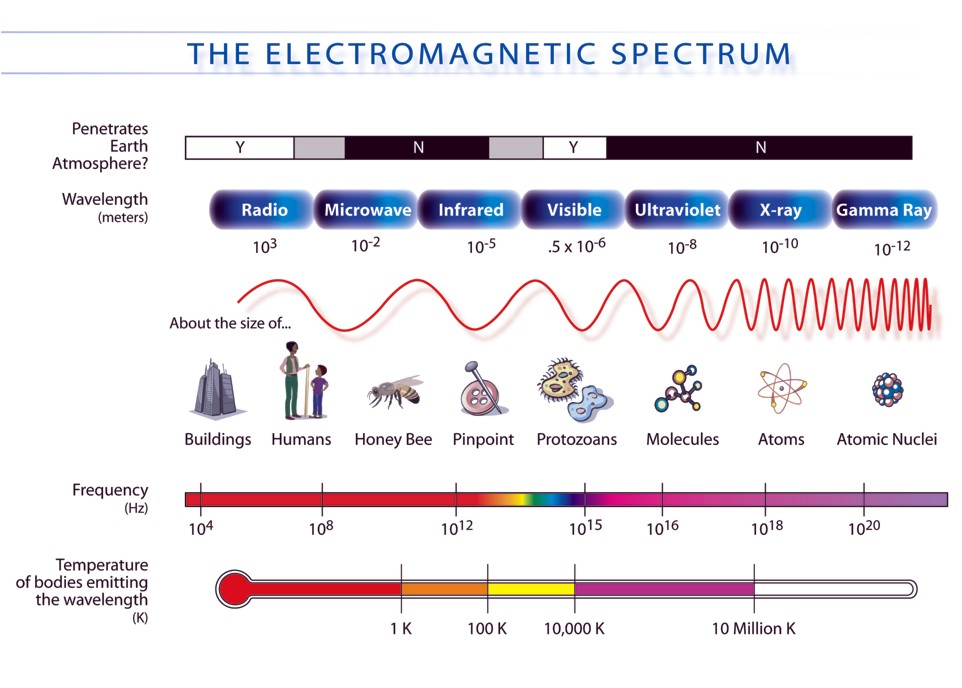Daniella Garcia-Loos
S
Saarah Hasan
AP Physics 2 🧲
61 resourcesSee Units
6.2: Electromagnetic Waves
We briefly mentioned electromagnetic waves in 6.1, but let’s review them a little and get a bit more in-depth. Once again, what is an electromagnetic wave?
An electromagnetic wave is a wave that’s capable of transmitting its energy through a vacuum; electromagnetic waves are produced by the vibrations of charged particles, don’t require a medium to travel, and are always transverse.
Some new stuff to dig into: electromagnetic waves are made up of electric and magnetic fields that oscillate perpendicular to each other. As shown in the image below, both fields are perpendicular to each other and perpendicular to their direction of motion as well.

Taken from Wikimedia Commons
Another thing to remember: When electromagnetic waves travel through a vacuum, they all travel at a constant speed c, which equals 3*10^8m/s (the speed of light).
v=λ*f becomes c=λ*f
Here are some key things to know about electromagnetic waves:
- Electromagnetic waves are a type of energy that travels through space at the speed of light (approximately 299,792,458 m/s).
- Electromagnetic waves are characterized by their frequency (measured in hertz) and wavelength (measured in meters).
- Electromagnetic waves do not need a medium to travel through, unlike mechanical waves such as sound waves, which need a medium like air or water to propagate.
- The electromagnetic spectrum is the range of all types of electromagnetic waves, from the longest wavelength (lowest frequency) to the shortest wavelength (highest frequency).
- Examples of electromagnetic waves include radio waves, microwaves, infrared radiation, visible light, ultraviolet radiation, X-rays, and gamma rays.
- Electromagnetic waves have a wide range of applications, including communication, medicine, and imaging.
The Electromagnetic Spectrum🌈
There’s a broad spectrum of wavelengths and frequencies that electromagnetic waves cover, and electromagnetic waves can be categorized by these two characteristics. The entire range of waves is called the electromagnetic (EM) spectrum. Types of waves on the EM spectrum include:
- Radio waves
- Microwaves
- Infrared
- Visible light
- Ultraviolet
- X-rays
- Gamma rays

Taken from Wikimedia Commons
The narrow band of wavelengths that the human eye can see is the visible light spectrum, whose colors in order of increasing wave frequency are red, orange, yellow, green, blue, and violet- remembered as ROYGBV. It’d be best to familiarize yourself with the names of the major categories of EM waves and ROYGBV.
Here are some key points about the electromagnetic spectrum:
- The electromagnetic spectrum is the range of all types of electromagnetic waves, from the longest wavelength (lowest frequency) to the shortest wavelength (highest frequency).
- The electromagnetic spectrum includes radio waves, microwaves, infrared radiation, visible light, ultraviolet radiation, X-rays, and gamma rays.
- Each type of electromagnetic wave has a different wavelength and frequency, and is associated with a different range of energy.
- Radio waves have the longest wavelengths and lowest frequencies, and are used for communication and navigation.
- Microwaves have shorter wavelengths and higher frequencies, and are used for communication, radar, and cooking.
- Infrared radiation has shorter wavelengths and higher frequencies than microwaves, and is emitted by warm objects. It is used for thermal imaging and heating.
- Visible light has even shorter wavelengths and higher frequencies, and is the part of the electromagnetic spectrum that is visible to the human eye. It is used for vision and lighting.
- Ultraviolet radiation has shorter wavelengths and higher frequencies than visible light, and is harmful to living tissue. It is used for sterilization and tanning.
- X-rays have shorter wavelengths and higher frequencies than ultraviolet radiation, and are used for medical imaging and cancer treatment.
- Gamma rays have the shortest wavelengths and highest frequencies, and are emitted by radioactive materials and nuclear reactions. They are used for cancer treatment and imaging.
A Connection to Everyday Life
Electromagnetic waves to the left of the spectrum—UV rays, X-rays, gamma rays—have high frequencies. Due to their high frequencies, these types of radiation have high energies, which can be detrimental to our health if precautions aren’t taken. That’s why we wear sunscreen whenever we go out and why lead shields are placed over parts of our body that aren’t being imaged whenever we get an X-ray.
Electromagnetic waves to the right of the spectrum—infrared rays, microwaves, radio waves—have low frequencies, so radiation from these types isn’t dangerous and doesn’t really affect our health.
Here are some key points about representations and models of electromagnetic waves:
Practice Problems:🧩
1. In the electromagnetic spectrum, rank the following electromagnetic waves in terms of increasing wavelength.


2. For the five types of electromagnetic radiation listed above, which of the following correctly describes the way in which wavelength, frequency and speed, change as one goes from the left to right on the list?
| Wavelength | Frequency | Speed | |
| A | Decreases | Decreased | Decreases |
| B | Decreases | Increased | Remains the Same |
| C | Increases | Decreases | Remains the Same |
| D | Increases | Decreases | Increases |
| E | Increased | Increases | Increases |
Answers:
- E: λ changes the opposite of frequencies (high freq = low λ) … based on this and knowledge of the EM spectrum, the answer is E.
- B: Known facts about the EM spectrum.
Browse Study Guides By Unit
💧Unit 1 – Fluids
🔥Unit 2 – Thermodynamics
⚡️Unit 3 – Electric Force, Field, & Potential
💡Unit 4 – Electric Circuits
🧲Unit 5 – Magnetism & Electromagnetic Induction
🔍Unit 6 – Geometric & Physical Optics
⚛️Unit 7 – Quantum, Atomic, & Nuclear Physics
📆Big Reviews: Finals & Exam Prep
📚Study Tools

Fiveable
Resources
© 2025 Fiveable Inc. All rights reserved.